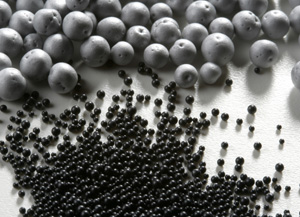Oct 31 2008
Particle-foam beads made of Neopor®, BASF’s innovative insulating material, have now been approved for retrofitting double-wall masonry with core insulation. As RigiBead® 035, sold by Saint-Gobain Rigips, Germany the expandable polystyrene granules (EPS) demonstrate their superior insulating capacity in comparison to conventional EPS when installed as so-called blow-in thermal insulation. This is used to modernize façades consisting of double-wall masonry and to render them more energy-efficient. So, the consumption of heating energy and the CO2 emissions of old buildings are considerably reduced.

Advantages of Neopor particle-foam beads for thermal insulation
Particle-foam beads made of Neopor entail several advantages over mineral insulating materials: they have a better thermal-insulation effect (thermal conductance WLG 035), are water-repellant and exhibit a low settling behavior. They are light, weighing around 18 kg/m³. Moreover, the particle distribution of the beads is very uniform, with a low percentage of fine beads. This ensures that rainwater cannot be conducted to the interior of the masonry via the insulating layer.
This technique also allows the layer of air that exists between the two masonry walls to be completely filled with insulating material. Since the structure of double-wall masonry inevitably limits the thickness of the insulation, the higher the insulating capacity, the better the results. Thanks to their high insulating capacity, Neopor beads efficiently meet these requirements when used for blow-in thermal insulation, thus complying with the stipulations of the German Energy Saving Regulations (EnEV) for the renovation of outside walls. In contrast to Great Britain, where several products made of Neopor have been officially approved for blow-in thermal insulation, in Germany, mainly hydrophobized mineral insulating materials having a thermal conductance between 040 and 070 have been employed until now.
Efficient and economical insulating measures
Double-wall masonry structures, that is to say, masonry on the inside and on the outside with a continuous layer of air in-between, provide adequate protection against rain, even in case of heavy downpours. These structures are one of the traditional construction techniques in numerous regions of Europe. Many old buildings made in this manner do not have sufficient thermal insulation, as a result of which the heating costs are comparatively high.
During the process of retrofitting with core insulation, compressed air is employed to blow the loose Neopor beads through a hose into the layer of air between the two masonry walls. The beads settle permanently without creating any hollow spaces. For a single-family home, this simple, clean and economical insulating procedure takes one day.
Insulating material for energy-efficient insulating systems
The expandable polystyrene Neopor is an innovative refinement of the classic insulating material, Styropor®. Insulation made of Neopor is silver-gray because it contains graphite, which considerably enhances the insulating capacity. Consequently, it is far superior to other insulating materials since its insulating capacity is up to 20% higher. This permits eco-efficient insulating solutions since the heating costs are lowered and the value of buildings is increased in an environmentally friendly manner. Typically, insulating materials made of Neopor are used for external walls, roofs and floors of both old and new buildings.